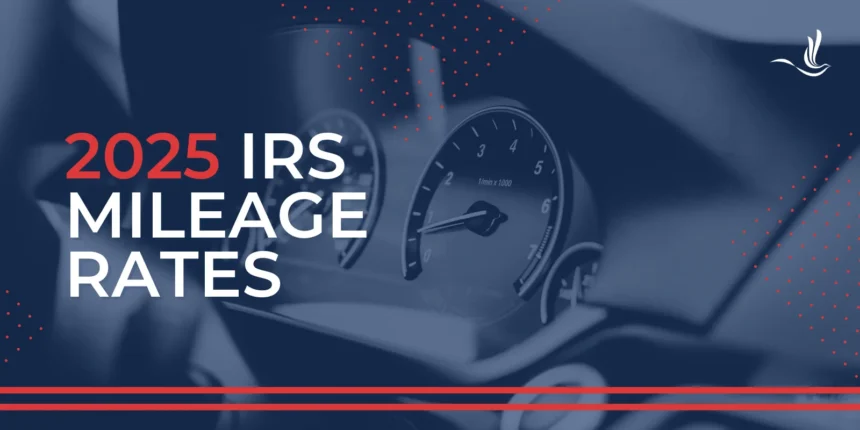For anyone who drives for business, medical, or charitable reasons, knowing the mileage rate for 2025 is essential for optimizing tax deductions and staying compliant with IRS regulations. This guide breaks down everything you need to know, from the updated rates to the best ways to track your mileage and maximize your savings.
What Is the Mileage Rate?
The mileage rate is the standard per-mile reimbursement rate set by the IRS. Instead of calculating actual expenses like gas, repairs, and insurance, taxpayers can use this simplified rate to deduct vehicle-related costs for qualifying activities.
The 2025 mileage rate was announced by the IRS to reflect increased vehicle operation costs, including gas prices and inflation. This rate applies to miles driven starting January 1, 2025.
The Mileage Rate for 2025
For 2025, the IRS has set the following mileage rates:
- Business use:67 cents per mile
- Medical and moving purposes:22 cents per mile
- Charitable service:14 cents per mile
These rates apply to cars, vans, pickups, and panel trucks used for the respective purposes.
Why the 2025 Mileage Rate Matters
Every mile you drive for qualifying purposes in 2025 could lead to meaningful tax savings. Whether you’re a contractor meeting clients, a rideshare driver, or someone volunteering for a nonprofit, tracking your mileage at the updated rate allows you to claim deductions that reduce your taxable income.
For Business Owners and Freelancers
If you log 10,000 business miles in 2025:
- 10,000 miles × $0.67 = $6,700 tax deduction
For someone in a 22% tax bracket, this could equal nearly $1,500 in savings.
For Medical Travel
Eligible medical travel includes visits to the doctor, pharmacy runs, or trips related to treatment. If you travel 500 miles for medical reasons:
- 500 miles × $0.22 = $110 deduction
For Charitable Work
The rate for charitable driving is fixed by federal law and hasn’t changed:
- 1,000 miles × $0.14 = $140 deduction
Who Can Use the Standard Mileage Rate?
Eligible Taxpayers
- Self-employed individuals:Freelancers, contractors, and gig workers.
- Active-duty military:For certain moving expenses.
- Volunteers:For charitable organizations.
Not Eligible (Post-TCJA)
- W-2 employees:Most cannot deduct unreimbursed business expenses, including mileage, due to the 2017 Tax Cuts and Jobs Act.
How to Track Mileage Effectively in 2025
Accurate tracking is vital if you want to claim the mileage rate deduction. The IRS requires detailed logs to substantiate your claim.
What to Include in Your Mileage Log:
- Dateof the trip
- Start and end locations
- Business or medical purpose
- Total miles driven
Best Tools for Mileage Tracking
- Everlance:Automates mileage tracking and integrates with tax software.
- MileIQ:Easy swipe-to-classify trips.
- QuickBooks Self-Employed:Syncs financial records and mileage in one dashboard.
Using these tools can help ensure that every mile you drive is accounted for—and deductible.
Choosing Between Standard Mileage and Actual Expenses
You have two main options for deducting vehicle expenses:
1. Standard Mileage Rate
- Simple to apply
- Ideal for those who don’t want to track gas, repairs, or depreciation
2. Actual Expense Method
- Requires tracking all vehicle costs (fuel, insurance, maintenance)
- May offer higher deductions for luxury or high-cost vehicles
Important Tip:
If you want to switch between methods, you must use the standard mileage rate the first year the vehicle is placed in service.
Common Deduction Mistakes to Avoid
- Claiming commuting miles:Travel between home and your regular workplace is not deductible.
- Inconsistent recordkeeping:The IRS can reject claims without adequate documentation.
- Mixing methods:You can’t switch between mileage and actual expenses within the same year.
Tips for Maximizing Your Deduction
- Track all trips consistentlyusing a dedicated app
- Log receiptsfor tolls and parking, which are deductible separately
- Review your mileage weeklyto avoid missing details
- Use separate vehiclesfor personal and business travel if possible
Final Thoughts
The mileage rate for 2025 offers a straightforward, efficient way to deduct driving costs associated with work, health, or charity. With the IRS setting the business rate at 67 cents per mile, it’s more important than ever to log your drives accurately and apply the deduction method that works best for your situation.
Whether you’re a solo freelancer, a full-time rideshare driver, or a small business owner, tracking your mileage now means fewer headaches and bigger returns during tax season.


